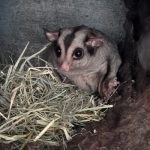MAHOGANY GLIDER
Mahogany Glider
The mahogany glider is one of Australia’s most elusive and endangered mammals – a small possum that sails silently through the warm, coastal forests of north‑eastern Queensland.
At a Glance
| Feature | Details |
|---|---|
| Common name | Mahogany glider |
| Scientific name | Petaurus gracilis |
| Family | Petauridae (gliders and some possums) |
| Conservation | Endangered (EPBC Act, QLD legislation) |
| Distribution | Coastal lowlands between Tully and Ingham, north‑eastern Queensland |
| Habitat | Open eucalypt woodland and forest with a mix of flowering species |
| Activity | Nocturnal, arboreal, gliding mammal |
What Does the Mahogany Glider Look Like?
Imagine a squirrel‑sized animal with the soft fur of a possum and the wings of a tiny, living kite.
Key features:
- Size:
- Head–body length: about 20–30 cm
- Tail: about the same length again, long and bushy
- Colour:
- Rich mahogany‑brown to grey‑brown across the back
- Paler cream or buff underside
- Darker stripe from the nose over the head
- Gliding membrane (
patagium):- A thin flap of skin stretching from forelimb to hindlimb
- When the glider leaps, it spreads its legs and the membrane turns its whole body into a living parachute
- Face and ears:
- Large dark eyes adapted for night vision
- Prominent ears that can detect tiny sounds in the canopy
The Mahogany glider is larger and more slender than its close relative, the Sugar glider, with a longer face and a more “stretched‑out” appearance – a clue to its species name gracilis, meaning “slender”.
Where Does It Live?
Mahogany gliders occupy a very narrow slice of Queensland’s coastal lowlands.
Geographic Range
- Confined to a small area between Tully and Ingham in north‑eastern Queensland.
- Mostly below about 120 metres elevation.
- This range is only around 120 km long and very narrow – like a thin ribbon of habitat along the coastal plain.
Habitat
They depend on open eucalypt woodlands and forests with:
- Mixed eucalypts (such as various gums and bloodwoods)
- Melaleucas (paperbarks) in wetter patches
- Flowering and sap‑producing trees that offer nectar, pollen and gum
- Hollow‑bearing trees for daytime shelter
You can imagine their home as a mosaic of gently rustling trees, with gaps for gliding and a diverse mix of species providing food throughout the year.
How Do They Live?
Night‑Time Flyers
Mahogany gliders are nocturnal. As dusk falls, they leave their tree hollows and begin to move.
- They can glide up to about 60 metres in a single leap.
- They launch from a high branch, limbs outstretched, patagium fully extended.
- Using their tail as a rudder, they steer through the warm night air and land with a soft, controlled “thump” against another trunk.
In the quiet of a north Queensland night, you might hear only a faint rustle of leaves as one passes by overhead.
Daily Routine
- Daytime:
- Rest in tree hollows lined with leaves and bark
- Often use several hollows within their home range
- Night‑time:
- Forage for food
- Glide between feeding trees
- Interact with their mate and neighbours at the edges of territories
What Do They Eat?
Mahogany gliders are omnivores, feeding high in the canopy.
Their diet includes:
- Nectar and pollen from flowering trees
- Insect prey such as beetles, moths and other small invertebrates
- Tree sap and gum, which they can lick from cuts in bark
- Occasional fruits and seeds
This varied diet means they rely on a diverse plant community. If certain trees are lost from their habitat, they may lose critical food sources, particularly at times of the year when only a few species are flowering.
Social Life and Breeding
Mahogany gliders form small, stable social groups, usually:
- A breeding pair (male and female)
- Sometimes one or two offspring from the most recent breeding season
Territory
- Each group maintains a territory that they defend from other groups.
- Territories may be 20–30 hectares or more, depending on habitat quality.
- Scent marking helps them keep track of boundaries.
Breeding
- Breeding usually occurs in the cooler months, but timing can vary with climate and food.
- Females have a pouch and usually raise one or two young at a time.
- Young stay in the pouch for around two months, then continue to ride on the mother’s back and shelter in hollows before becoming independent.
Because they have low reproductive rates, populations cannot quickly recover from big losses caused by habitat destruction or severe storms.
Why Is the Mahogany Glider Endangered?
Despite its agility and adaptability in the trees, the mahogany glider faces serious threats.
Major Threats
Habitat Loss and Fragmentation
- Large areas of coastal forest have been cleared for agriculture, plantations, grazing, and development.
- What remains is often broken into small patches, separated by open fields or roads.
- These gaps can be too wide to glide across safely, cutting populations into isolated fragments.
Habitat Degradation
- Logging or changes in fire regimes can remove:
- Hollow‑bearing trees
- Key flowering and sap‑producing species
- This reduces both shelter and food.
- Logging or changes in fire regimes can remove:
Infrastructure and Roads
- Roads, powerlines and other infrastructure cut through habitat.
- Without canopy connections or special glider poles, mahogany gliders must come to the ground, where they are vulnerable to:
- Vehicle strike
- Predation by cats, dogs and foxes
Climate and Extreme Weather
- Cyclones and intense storms can flatten or strip forests, removing food and shelter at a landscape scale.
- Droughts and heatwaves can further stress trees and reduce flowering.
Conservation Efforts
The mahogany glider is a flagship species for lowland forest conservation in north‑eastern Queensland. Protecting it helps many other species that share the same habitat.
Key Conservation Actions
Habitat Protection
- Securing remaining forests in reserves and conservation covenants.
- Preventing further clearing of critical habitat areas.
Habitat Restoration
- Replanting native trees, especially:
- Hollow‑forming eucalypts
- Nectar‑rich species
- Creating continuous habitat corridors so gliders can move between patches.
- Replanting native trees, especially:
Canopy Connectivity
- Installing glider poles and canopy bridges over roads and cleared areas to reconnect forest patches.
- Maintaining tree lines along fence lines and waterways to act as glide paths.
Research and Monitoring
- Mapping populations and habitat quality.
- Using spotlight surveys, call recorders and habitat assessments to track trends.
Community Involvement
- Local landholders managing their trees and woodlots to support glider habitat.
- Citizen science programs that record sightings and help locate important habitat.
Why This Species Matters
The mahogany glider is not just a rare animal; it is a symbol of an entire ecosystem.
- By feeding on nectar and pollen, it helps pollinate trees.
- By eating insect prey, it plays a role in insect population control.
- Its need for large, intact habitat makes it a strong indicator of forest health.
Protecting this glider means safeguarding:
- Native eucalypt woodlands and paperbark forests
- Other threatened species that share the same habitat
- The natural character of Queensland’s lowland coastal landscapes
How People Can Help
Even if you do not live in north Queensland, there are ways to contribute to the survival of species like the mahogany glider:
- Support organisations that protect and restore native habitat.
- Choose sustainably sourced products that reduce pressure on forests.
- Learn about and share the story of endangered Australian wildlife to build awareness.
- If you are in the region:
- Keep and protect native trees on properties where possible.
- Control feral predators such as foxes and cats.
- Report sightings to local conservation groups or wildlife authorities.


